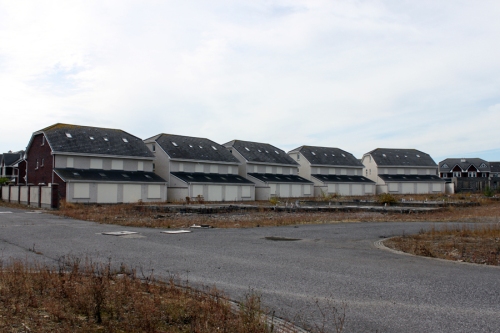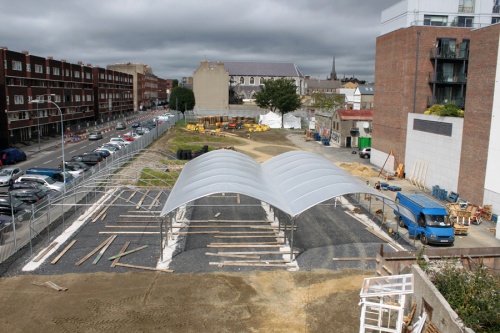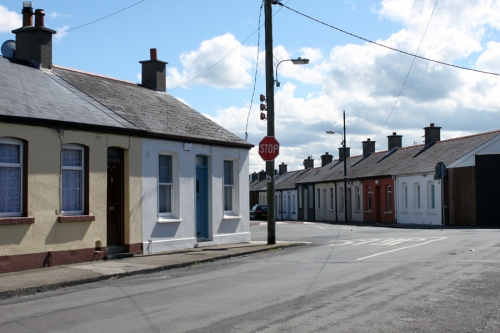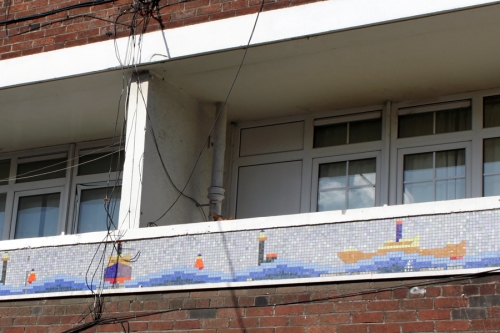Dublin’s Ghost Estates
I know it has been a while, so I will try a fresh start with something quite interesting, yet slightly upsetting. I am going to introduce you to two of Dublin’s ghost estates, shocking reminders of the “celtic tiger” era, the Irish economic craze that abruptly ended in 2009.
I captured these morbidly picturesque views this summer on a cycle between Dublin and Portmarnock, just about ten kilometres North of the capital’s city centre. Castlemoyne Balgriffin is one of the many estates in Ireland built and left unfinished when the developer went bust in 2009. Even finished property remained largely abandoned due to the isolated location with no access to public services or transport.
Of course this is no news and on top of that a delicate and painful subject to many house owners and mortgage holders. So why posting these pictures now? Well, it was announced yesterday that the government will pay for the demolition of the worst ghost estates across Ireland. According to the Sunday times, “Housing minister Jan O’Sullivan has drawn up a hit list of 40 unfinished estates at which site clearance will begin in 2014. More developments will be added where it is clear houses can never be sold on the open market.” Affected areas are believed to be concentrated in the western and midland counties of Leitrim, Roscommon, Longford, Cavan and Offaly.
And once again tax payers are cleaning up the mess that investors and developers (of which many were banks) have left behind… Even more disturbing is the fact that these “luxurious family homes” on the country side got planning permission as quickly as they will be demolished again!
 From above the different building stages of Castlemoyne housing estate are clearly visible.
From above the different building stages of Castlemoyne housing estate are clearly visible.

 Construction stopped after foundation works, or ground floor construction respectively
Construction stopped after foundation works, or ground floor construction respectively
 “Luxurious 5 Bedroom Family Homes” – A bill board reminds of glorious celtic tiger promises.
“Luxurious 5 Bedroom Family Homes” – A bill board reminds of glorious celtic tiger promises.

 A fence right across the road marks the transition between finished and unfinished. Whether homes are occupied or not is a lot harder to detect. Gardens are neatly kept in shape but stickers on the inside of windows reveal the truth. The street below was entirely vacant, however the rest of the estate is partly occupied.
A fence right across the road marks the transition between finished and unfinished. Whether homes are occupied or not is a lot harder to detect. Gardens are neatly kept in shape but stickers on the inside of windows reveal the truth. The street below was entirely vacant, however the rest of the estate is partly occupied.


 A construction fence close by that became permanent.
A construction fence close by that became permanent.
Another eye sore not far away from above ghost estate is Priory Hall. This newly finished complex in Northern Donaghmede had been declared a fire hazard in 2011 and was hence evacuated. House owners were set on the street without compensation as the developer went bankrupt. “Those residents, unable to move back into houses they still had to pay for, have spent nearly a year in legal limbo, high-profile casualties of the corruption and recklessness of the Irish boom in the 2000s.” “Temporarily staying in housing provided by the Dublin City Council, its residents were still required to keep up mortgage payments on their deteriorating apartments. Meanwhile, the council, which was ordered by a court to take responsibility for the tenants and has already spent more than $2 million housing them, had gone back to court to avoid paying any more. (The New York Times) It cost the life of a mortgage holder who tragically committed suicide this year, in order for authorities to agree to pay their rent for another 12 months and banks involved “to release owner-occupiers from their mortgages and offer them new loans to buy homes elsewhere.” (Irish Times)





 The site before the build up, just a few weeks ago!
The site before the build up, just a few weeks ago! Granby Park this Sunday….
Granby Park this Sunday…. … and today!
… and today!
 Construction work on the pallet amphitheatre went on until late tonight..
Construction work on the pallet amphitheatre went on until late tonight.. Polytunnel construction
Polytunnel construction Volunteers making tree planters from pallets
Volunteers making tree planters from pallets
 Teens from Dublin and Belfast are building the amphitheatre as part of a reconciliation project
Teens from Dublin and Belfast are building the amphitheatre as part of a reconciliation project
 The grass has been manually “transplanted” from a neighbouring vacant site!
The grass has been manually “transplanted” from a neighbouring vacant site!
 Watering plant donations
Watering plant donations
 Local volunteers painting the fence
Local volunteers painting the fence Discrete advertising – a lovely herald for Granby park spotted on Exchequer Street today.
Discrete advertising – a lovely herald for Granby park spotted on Exchequer Street today. 

 Fence knitting action…
Fence knitting action… The good vibes spill over: Tenants painting their walls at Dominick Flats!
The good vibes spill over: Tenants painting their walls at Dominick Flats!





















 The elegant old warehouse building on King’s Inn Street has been rediscovered by the
The elegant old warehouse building on King’s Inn Street has been rediscovered by the 




















